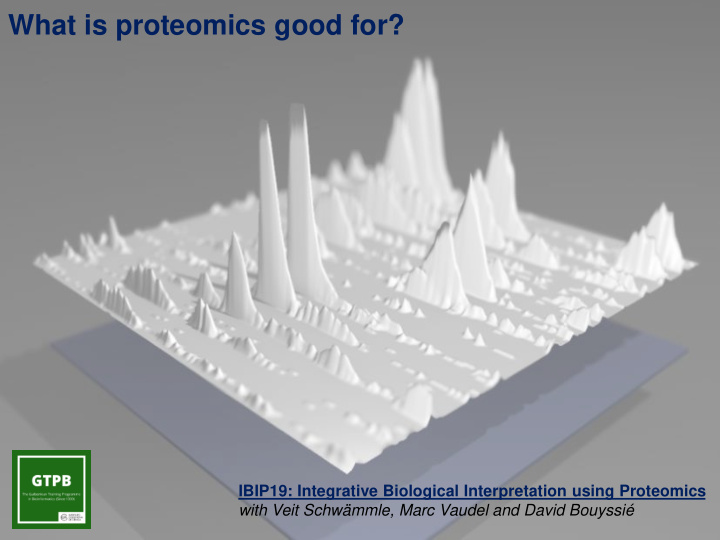



What is proteomics good for? IBIP19: Integrative Biological Interpretation using Proteomics with Veit Schwämmle, Marc Vaudel and David Bouyssié 1
Introduction What is proteomics? What is the complementarity with other omics? THE PROTEOME : “ The entire protein complement expressed by a genome, or by a cell or tissue type. ” Wilkins. et al . 1996 Complexity of human genome, transcriptome and proteome ~20 000 ~100 000 >1 000 000 proteoforms genes ARNm Same genome … … different proteomes The proteome is very dynamic Proteins are cells effectors central players in pathologies: cancer, infections, etc… PROTEOMIC ANALYSIS: Identify, characterize and quantify the proteins in given conditions
Introduction What information can we get from the proteome? GENOME VS PROTEOME: “ The genome might enable us to predict the proteins that can potentially be generated but not where, when or at what level ” E. H. Fischer (1997) 😅 “ If the proteome was a cake then the genome would be recipe ” David Bouyssié 2019 With the same ingredients but different conditions we can obtain very different cakes! The proteome (as the lipidome and the metabolome) reflects the state of studied biological system
Introduction What can we do with proteomics? SYSTEMATIC ANALYSIS: Characterize the set of proteins present in a given biological system STRUCTURAL ANALYSIS (Native MS, Top-Down, HDX) Study the 3D structure of proteins and their association in molecular complexes FUNCTIONAL ANALYSIS: DIFFERENTIAL/QUANTITATIVE ANALYSIS Comparison of proteomes obtained in different conditions e.g.: drug effect, biomarker discovery in biologicial fluids PROTEIN/PROTEIN INTERACTIONS (INTERACTOMICS) Characterization of protein partners implied in the creation of a molecular complex having a functional role POST-TRANSLATIONAL MODIFICATIONS Identification, localization and quantification of proteins having post-translational modifications (PTMs). e.g.: phosphoproteome
Introduction Functional analysis focus: post-translational modifications PTMs functions: • Signal transduction • Gene expression • Protein turnover • Regulation of protein and cell-cell interactions • Metabolism and coupling of metabolism and gene expression • Host-pathogen interactions
Introduction Functional analysis focus: post-translational modifications Question: is there a PTM « cross-talk »? Functional consequences of [Ubi + Phospho] versus Ubi or Phospho alone Synergy? Inhibition? Beltrao P, et al. Mol Syst Biol. 2013 PTMs <-> amino acids relationships Example of highly modified protein: Histone H4
Introduction What information can we get from the proteome? Molecular interactions Protein complexes Post-Translational Localization and characterization Modifications (issues: membrane proteins, (PTMs) low abundant proteins) Figure adapted from Patterson, S.D. & Aebersold, R.H; Nature Genetics 2003
Recommend
More recommend